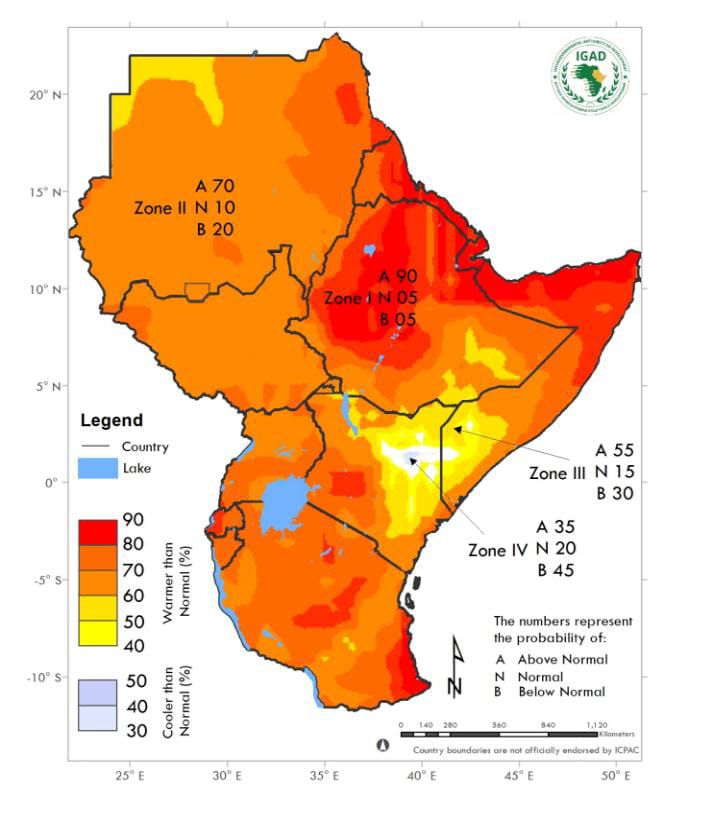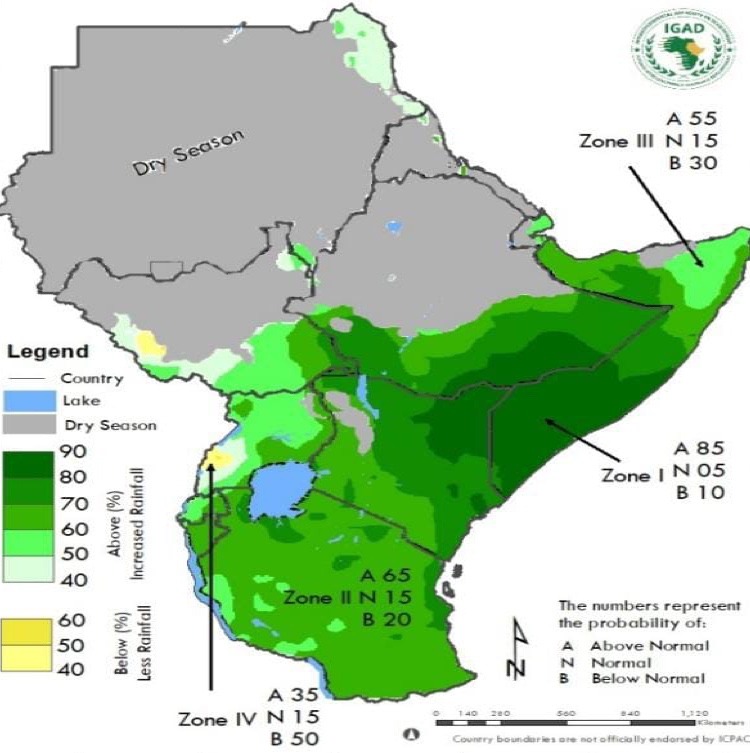Climate scientists in the Horn of Africa Region say there is a likelihood that the region is set for wetter than normal weather conditions during the short rain season of October to December.
In a forecast released by the Igad Climate Predictions and Applications Center (ICPAC) the October to December (OND) short rains season will see the region experiencing above-normal rainfall. The climate scientists say that the forecast which is corroborated by that of nine other Global Producing Centers (GPCs) and customized for the Greater Horn of Africa (GHA) “indicates a heightened likelihood of experiencing more abundant rainfall (above normal rainfall) over almost all of the region from October to December 2023,” says the statement read by the Permanent Representative of Kenya with the World Meteorological Organisation (WMO) Dr. David Gikungu.
While noting that the OND constitutes an important rainfall season in the Horn of Afria region, the specialized climate institution of the Intergovernmental Authority on Development (IGAD) further indicates that there is an exceptionally high forecast probability of over 80% of experiencing “wetter than normal rainfall conditions in the eastern parts of the region, encompassing southern Ethiopia, eastern Kenya, and southern Somalia.”
The OND rainfall interannual variability is strongly linked with the Sea Surface Temperature (SST) conditions in the eastern and central equatorial Pacific, where wetter than normal conditions typically occur during the El Niño weather phenomenon. These conditions are driven by, the El Nino Southern Oscillation (ENSO) and the Indian Ocean Dipole (IOD) are ocean-to-atmosphere phenomena associated with global atmospheric and oceanic circulation changes that influence regional climate conditions by modulating regional circulation patterns, especially monsoonal winds, and upper-level and low-level winds. Their effects also are modulated by topography and large inland water bodies.
 In his presentation at the 65th Greater Horn of Africa Climate Outlook Forum (GHACOF 65) Climate Scientist with the UK Met, Dr. Stefan Lines said that the presence of El Nino conditions in the Eastern Equatorial Pacific Ocean which releases oceanic heat into the atmosphere and increases global temperatures, the horn of Africa region may receive heavy rainfall. Dr Lines says records have shown that with a positive Indian Ocean Dipole (IOD) during the short rains season, the region could be heading to a season of heavy rainfall.
In his presentation at the 65th Greater Horn of Africa Climate Outlook Forum (GHACOF 65) Climate Scientist with the UK Met, Dr. Stefan Lines said that the presence of El Nino conditions in the Eastern Equatorial Pacific Ocean which releases oceanic heat into the atmosphere and increases global temperatures, the horn of Africa region may receive heavy rainfall. Dr Lines says records have shown that with a positive Indian Ocean Dipole (IOD) during the short rains season, the region could be heading to a season of heavy rainfall.
The current forecast is further underpinned by its closeness to what was experienced in 1997, and 2006, the conditions present in the Equatorial Pacific and the Indian Ocean Dipole in the Indian Ocean, “This is especially pertinent this year due to the notably elevated likelihood of above-average rainfall, mostly in the eastern parts of the region.”
The forecast further indicates an increased likelihood of warmer-than-average surface temperatures for almost all parts of the GHA with “probabilities of warmer than average temperatures over Djibouti, Eritrea, northern Ethiopia, northern Somalia, and parts of coastal Tanzania,” the statement says in part and adds, “In contrast, over certain isolated parts of eastern Kenya and the bordering areas between Kenya and Somalia, probabilities favour cooler-than-normal conditions.” On the other hand, for isolated areas of southwestern Uganda and southwestern South Sudan, probabilities favour drier than average (below-normal) conditions.
Speaking during the 65th Greater Horn of Africa Climate Outlook Forum (GHACOF 65) a Climate Scientist with the Igad Climate Predictions and Applications Center (ICPAC) Kennedy Kimathi said that the region could suffer a desert locus invasion.
He noted that already mature desert locust swarms have been spotted in Sudan and parts of Tigray in Ethiopia and that with “the region headed for wetter than normal conditions during the October to December short rains season and coupled by the evolving el nino phenomenon, the weather conditions will provide a suitable environment for the desert locus swarms to thrive.”
Kimathi is urging the IGAD member states to put in place early action mechanisms by putting in place measures to contain the locusts in their breeding grounds before the spread to other countries.





